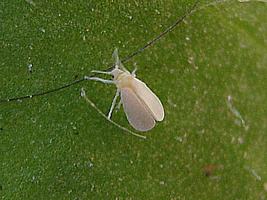The whitefly is one of the most well-known pests in the world and is present in virtually all agricultural regions. Technically, it is not a fly, as it belongs to the Hemiptera order, the same as aphids and stink bugs, and not to the Diptera order, which includes common flies. A practical rule to avoid confusion is the number of wings: Hemiptera have four wings while Diptera have two. There are two species particularly known as pests, Bemisia tabaci and Bemisia argentifolii. The latter is known for being more destructive and resistant to certain insecticides.
The whitefly is very small, measuring 1 to 2 millimeters and has a white to pale yellow coloration, with black eyes that stand out on the insect’s body. When at rest, it keeps its wings closed, appearing to have only one pair. It does not move quickly, making it easy to capture, however, it has a great capacity for dispersion due to the number of eggs, 200 on average per female, and the action of the wind as a dispersing agent. It prefers drier climates, where its longevity and fertility are higher.
The damage caused by the whitefly includes, in addition to the sucking of sap that weakens plants, the deposition of toxins that cause uneven growth of plant tissues. Also, like aphids, the whitefly secretes a sugary substance that allows the development of sooty mold, a type of dark fungus that prevents photosynthesis in plants.
Another damage, perhaps the most important in some crops, is the fact that this pest is a transmitter of Begomovirus and VMDF (golden mosaic virus of beans). The whitefly infests many species of well-known plants, such as tomatoes, beans, soybeans, broccoli, and various ornamentals. It is also found in weeds present in gardens, vacant lots, and commercial crops.
The control of whitefly on a large scale is carried out via the application of insecticides, especially in crops like soybeans and beans. In smaller areas such as vegetables and ornamentals, preventive control is suggested. The acquisition of healthy seedlings, rapid eradication of sick plants, and crop residues are actions that prevent whitefly infestation. We can also use yellow traps, made of canvas, plastic, labels, etc., coated with oil. These should be placed among the plants, at the same height as the plants in the area.
There are various natural enemies of the whitefly, including several species of stink bugs, dung beetles, beetles, and wasps. There are also species of parasitoids from the genera Encarsia, Erectomecerus, and Amitus. By carrying out prevention and/or rational chemical control, we can maintain and even increase the presence of these natural enemies of the whitefly.


